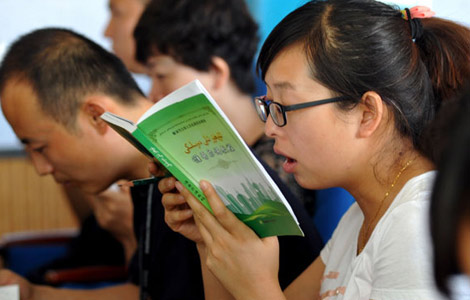Chinese students head overseas at younger ages
Updated: 2013-08-02 00:33
By WANG ZHUOQIONG (China Daily)
|
||||||||
Parents protect children from exam pressures by sending them abroad
Next month, Chen Deming, 13, will enter a junior high school in the United States.
His parents are going along. His mother, Kang Qingjun, 43, is gearing up to learn to drive, and she's practicing her conversational English.
 |
|
Chinese families now know more about overseas education, and they have more money to pay for it, leading to a decline in the average age of overseas students.[provided to china daily] |
"Chinese parents will scrimp on many things, but not education," said Kang. "We've saved enough money for him to finish his studies."
To protect their children from the pressure of the fierce competition faced by millions of college-bound exam takers in the country, an increasing number of Chinese parents are sending their sons and daughters abroad, making the country the leading exporter of students.
Chinese families now know more about overseas education, and they have more money to pay for it. One result is that the average age of students headed overseas is declining significantly, creating a huge market for domestic training agencies and foreign educational institutions.
According to the Center for China and Globalization, a non-profit think tank, in 2010, nearly 20 percent of all Chinese overseas students held an academic certificate below the high school level. But in 2011, the figure had risen to 22.6 percent.
Those taking the TOEFL exam (an English language test) and the SAT (a college admissions exam widely used in the United States) are becoming younger, with many now aged under 18.
Fan Meng, director of the North America exams department of New Oriental Education and Technology Group, a leading test preparation company in China, has observed the rising number of younger students in the company's prep classes for high school and college admissions exams.
Students aged under 18 taking the TOEFL test increased 30 percent last year from 2011, he said.
Fan said the explosive growth is most visible among students who are headed to primary schools or senior high schools.
Further, he said, the students and their parents are becoming very well-informed about education overseas.
When selecting schools, these families emphasize the importance of improving students' creativity and innovation, while maintaining their individuality, Fan said.
Marvin Mao, chief executive officer of the online overseas education network ShareWithU, said he found more Chinese youngsters starting their foreign education at the junior high school level. Mao said this earlier start allowed students to adjust better to their new environments.
He said the number of Chinese high school students heading overseas has been surging since 2010, and there has been big growth in the number of applicants for junior high schools and primary schools this year.
Mao said the trend of studying abroad at a younger age is expanding to second- and third-tier cities.
Foreign high schools that have struggled with funding since the 2008 global crisis have been eager to attract more international students, Mao said. For example, about 300 high schools in the US are recruiting students from China, he said.
But having the high school or college experience in the US, a popular destination for many in China, doesn't come cheap: It can cost 200,000 yuan ($32,630) to 600,000 yuan a year, including tuition and living expenses. That's the annual income of many Chinese families.
Foreign education groups, for their part, hope to cash in on the lucrative Chinese market, industry experts said.
Annette Madjarian, spokeswoman for Navitas Group, a leading global education provider based in Australia, said though the company hasn't detected a clear difference in the average age of students enrolling in academic English courses prior to their undergraduate or postgraduate courses, the number of students enrolling in academic English followed by foundation courses has grown and this group is slightly younger.
In the past year or two, Navitas has seen more students choosing to start their studies with the lower-level academic English courses.
Annual increases have been about 10 percent in these courses in the past two years and stable in the highest-level academic English courses, she said.
At Bell Educational Services Ltd, a London-based education company, one of the courses that's attracting the largest number of Chinese students is the summer young learner course, which is designed for children between seven and 17 years old, according to Greg Watson, chief executive of Bell.
Over the past three years, about 1,000 Chinese students have studied at Bell for an average of about three weeks, at a typical cost of 2,000 pounds ($3,030) to 3,000 pounds.
The average age of Chinese students taking Bell's young learner course has fallen from 17 in 2012 to 14 in 2013, according to the company.
The proportion of Chinese students aged 10 or under was 10.5 percent in 2013, while it was only 1.9 percent in 2011. Similarly, the proportion of students aged between 11 and 14 years soared from 5.2 percent in 2011 to 24 percent in 2013.
Bell believes that there is a general trend toward younger learners studying overseas, and it has restructured its curriculum to meet the needs of students of different ages and ambitions.
Watson said China is a key country for Bell's development because of its economic growth, its international ambitions and its commitment to education.
"We want to build long-lasting strategic partnerships with a range of Chinese organizations, such as schools, universities and private education providers," said Watson.
Students from China are definitely starting their educational journey in the United Kingdom at an earlier age, said Katie Latimer, recruitment and marketing manager of Astrum Education, a London-based education group.
Based on current international student enrollments, their General Certificate of Secondary Education program recruitment for September is significantly up on 2012 figures. GCSE applications from Chinese students have increased by more than 50 percent, she said.
This trend has a positive effect on the overall performance of Chinese students, not only academically, but also from a social and language development perspective, said Latimer.
"The longer an international student is immersed in this sort of environment, the better adjusted they are for their future educational and career journey," she said.
A key benefit of their study experience with Astrum is the opportunity to study alongside British students, to make friends, exchange ideas and improve their language skills to the level demanded by the most prestigious UK universities. Younger students tend to be very adaptable, said Latimer.
However, she said that many parents in China feel that 14-year-olds are too young to be away from home, so their A-Level applications from Chinese students aged 16 years and above remain strong.
Chinese students currently account for about 15 percent of Astrum's overall international student cohort, but the company expects it to rise to about 20 percent for the coming academic year.
Fan of New Oriental said that the growth in the number of applicants from China for a fixed number of schools overseas means mounting difficulty in actually getting into a top school.
"Colleges and middle schools are not going to expand their enrollment only for the Chinese market," said Fan.
"Unless Chinese students lower their expectations about getting into the leading schools, the bar for Chinese applicants will only go higher."
Most Viewed
Editor's Picks

|

|

|

|

|

|
Today's Top News
Food program aims to address security
China faces world's worst managerial shortage
Soybean is king in American exports to China
China sails through 'first island chain'
US should reclaim 10% share
Chinese worry about image abroad
China blasts US Senate resolution
NSA chief details program at hackers' conference
US Weekly

|

|
















